Today is the 15th straight day of absolutely beautiful weather here in the Ozarks. With nearly cloudless skies, temperatures have been climbing up around to 80° during the day and dropping to 50° or so at night. The next two days look to break the string with a chance of rain each day and cooler temperatures arriving by the end of the week. This is October after all and the area should experience a killing frost by the end of the month. But until that happens, the insects are still out in numbers and some very interesting caterpillars have placed themselves in front of my camera recently.
First up is the caterpillar of the Funerary Dagger Moth (Acronicta funeralis.) This is one of the few caterpillars (as opposed to the adult moth) that has a common name – the Paddle Caterpillar – for the paddle-shaped hairs projecting from each body segment.
The adult is a non-descript gray moth with a wingspan of an inch and a half or so. The larvae feed on a variety of plants including cottonwood, dogwood, oak, maple willow, apple, alder and hickory. Occurring from Manitoba to Nova Scotia, south to Georgia and west to Texas (though apparently missing from some of the midwestern and southern states) and along the west coast from California to British Columbia, A. funeralis produces one to two or more generations depending on how far north or south you’re looking.
Next is the Fall Webworm, Hyphantria cunea. This time, it’s the adult moth that doesn’t have a common name.
Usually considered a pest due to the leaf and branch enclosed webs it produces in late summer and early fall, H. cunea is native and common from Mexico to Canada with up to four generations produced in a year. Unfortunately, an introduced population occurs in Europe and Asia. The adult has a 1-1/2 inch wingspan and is mostly white in the northern part of it’s range, but with black or brown spots on the forewing in the south. The larvae feeds on nearly any deciduous tree; more than a hundred species have been identified as hosts.
Here we have the caterpillar of the American Dagger Moth, Acronicta americana.
Reaching two inches, the caterpillar can be white or yellow with paired black tufts on the first and third abdominal segments and a single tuft on the eighth segment. The hairs have been known to cause skin irritation in humans. Occurring from the Rockies east, this is a creature of the forest, those in the bottomlands particularly, the larvae feeding on the leaves of many deciduous trees including hickory, maple, oak, walnut and elm. The adult is the largest dagger moth in the east with a wingspan of 2-1/2 inches, but still qualifies as a “non-descript, gray-brown moth.” Up to three generations per year can occur in the southern part of its range.
This one is probably my favorite caterpillar of all, the White-marked Tussock Moth, Orgyia leucostigma.
This caterpillar looks like a meth-using redneck – who had been playing with a Mr. Potato Head – took a bunch of caterpillar parts and stuck them on willy-nilly. It must have went something like this:
“Gimme the yeller and black striped one. Now a purple, no, red head – I like redheads – and we gotta have lots of them there bristly things. There ya go, that’s the ticket. We can put these white brushy things here and them red things on his back end. And I don’t know what this thing is, but I like it. Stick it in his butt. Git ‘er done.”
And it worked. This caterpillar is beautiful. Of course anything this outrageous looking is screaming “Eat me! I dare you! But you’ll be SORRY!” And for good reason. It has defensive glands (the “red things on his rear end”) and the hairs can cause an allergic reaction in humans.
Common throughout the eastern United States and Canada, O. leucostigma produces at least two generations annually, overwintering as eggs. The caterpillars are not picky eaters, taking a wide range of deciduous trees and even some conifers. The females are wingless, emerging from her cocoon to send waves of pheromones that bring the males, who do have wings but no mouth-parts, zipping to her. After laying her eggs on herself or her cocoon and covering them with froth, the female dies. You would think that since the females are wingless, dispersal would be limited to the distance that those little caterpillar legs could carry them. But the newly hatched and very tiny caterpillars toss a line of silk to the wind and go ballooning, much like some spiders. Nature is never boring.
Here is our last caterpillar for today:
I’ve narrowed it to the genus Lochmaeus, but the genus has two species, L. bilineata (Double-lined Prominent) and L. manteo (Variable Oakleaf Caterpillar), and they are indistinguishable as larvae. It was munching on an oak leaf, but that doesn’t help because both species eat oak along with those of other deciduous trees. Range doesn’t help either since they’re both widespread and occur here. However, L. manteo is capable of spraying formic acid that can irritate your skin and even cause blisters. So, if I prod and pest the caterpillar until he sprays me, he’s L. manteo.
Maybe I can find a volunteer to help with that experiment. Where’d that methed-up redneck go? ![]()
Now, after all of those “icky” caterpillars, let’s cleanse our palates with a lovely Monarch butterfly.
Of course, that beautiful butterfly used to be an icky caterpillar too.
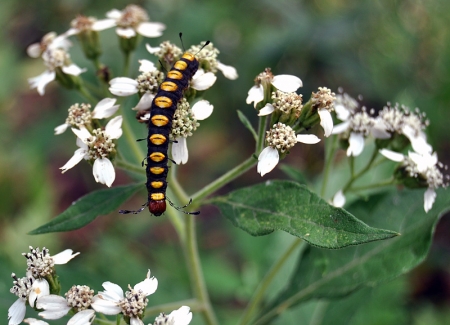
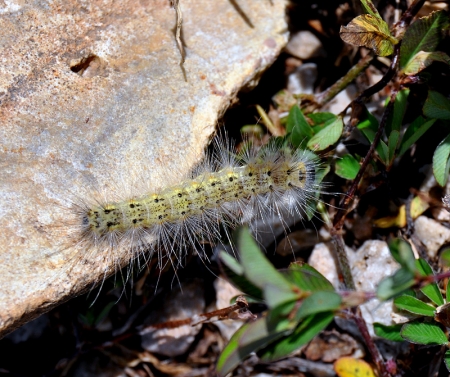
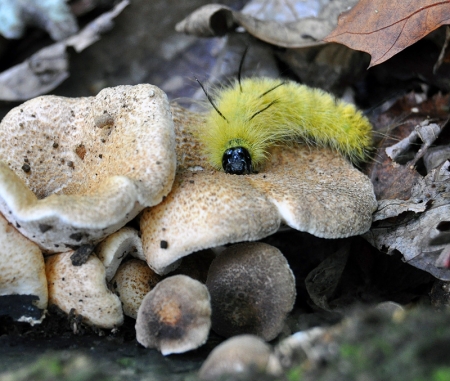
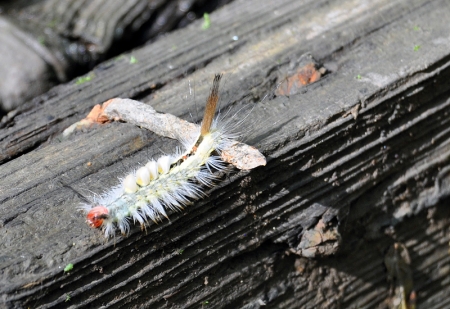
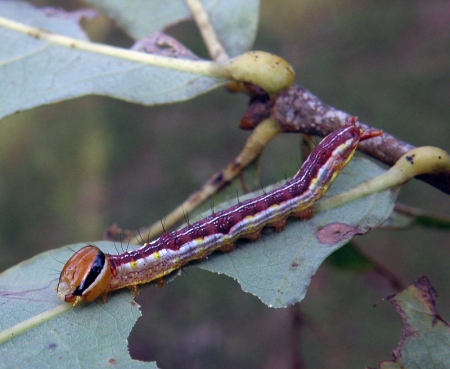
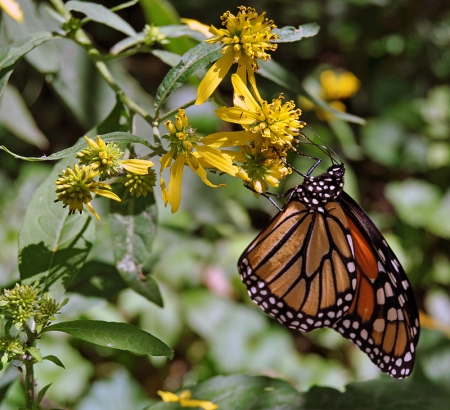
Dear Mr. Swofford,
I accidentally found your website today while searching the web to try and find out where in the world all the thousands of caterpillars are coming from in S.W. MO. and northern AR.
I live in a small apt. above a garage on Table Rock so I am half way up some of the trees which hang over my deck.
There are so many of them, that they fall out of the trees and into your hair and down your shirt amongst other places.
At night they huddle together to stay warm.
I’ve never seen this before and you seem like you are a genuine person with a good sense of humor, {Loved the redneck/Mr. Potato head thing on your post}, so I thought I would ask your thoughts on this. It would be hard to describe them, but maybe send photos if you are interested.
Just a little about me, so you know you’re not dealing with some kind of FREAK. I have lived near and work for the City of Hollister MO for more than 9 yrs. and am D.N.R. certified wastewater plant operator for the City, 56 yrs. old Native Missouri boy from near K.C.
Now that YOU are bored, I will cut this off and simply say, Howdy and thanks for your kindness in taking time to read it!
Thanks,
Mark Barrie-pronounced berry
Hi Mark,
I’m sorry it took me so long to reply to you, but I haven’t exactly been keeping up with the site lately. I apologize and thank you for taking the time to leave a comment.
As for the caterpillars, I’m not sure what they would be. I haven’t seen anything like what you’re describing this fall, but you’re a hundred and fifty miles or so west of me, so it’s not that surprising that you’re seeing an outbreak and we’re not.
I did notice a large number of webs or tents out at Peck Ranch back in September, but I was looking for rutting elk, assumed they were fall webworms (Hyphantria cunea) and didn’t investigate more closely.
I can’t resist a mystery and would indeed like to see any photos you have. If I can’t identify them, I have some pretty good contacts and I’ll bet we can figure them out.
Dan